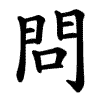Definify.com
Definition 2026
疋
疋
Translingual
| Stroke order | |||
|---|---|---|---|

| |||
| Stroke order (alternative) | |||
|---|---|---|---|

| |||
Han character
疋 (radical 103 疋+0, 5 strokes, cangjie input 弓卜人 (NYO), four-corner 17801, composition ⿱乛龰)
- roll, bolt of cloth
- foot
- Kangxi radical #103, ⽦ (“bolt of cloth”).
Derived characters
- Index:Chinese radical/疋
- 楚
Related characters
References
- KangXi: page 767, character 16
- Dai Kanwa Jiten: character 21994
- Dae Jaweon: page 1177, character 18
- Hanyu Da Zidian: volume 4, page 2749, character 1
- Unihan data for U+758B
Chinese
Etymology 1
|
simp. and trad. |
疋 | |
|---|---|---|
Pronunciation
- Mandarin
- (Standard Chinese, Beijing)+
- Pinyin:
- Zhuyin: ㄕㄨ
- Wade-Giles: shu1
- Gwoyeu Romatzyh: shu
- IPA (key): /ʂu⁵⁵/
- (Standard Chinese, Beijing)+
- Cantonese
- (Standard Cantonese, Guangzhou)+
- Jyutping: so1
- Yale: sō
- Cantonese Pinyin: so1
- IPA (key): /sɔː⁵⁵/
- (Standard Cantonese, Guangzhou)+
- Min Nan
- (Hokkien)
- Pe̍h-ōe-jī: su
- Tâi-lô: su
- Phofsit Daibuun: sw
- IPA (Xiamen): /su⁴⁴/
- IPA (Quanzhou): /su³³/
- IPA (Zhangzhou): /su⁴⁴/
- IPA (Taipei): /su⁴⁴/
- IPA (Kaohsiung): /su⁴⁴/
- (Hokkien)
| Rime | |||
|---|---|---|---|
| Character | 疋 | 疋 | 疋 |
| Reading # | 1/3 | 2/3 | 3/3 |
| Initial (聲) | 生 (21) | 生 (21) | 疑 (31) |
| Final (韻) | 魚 (22) | 魚 (22) | 麻 (98) |
| Tone (調) | Level (Ø) | Rising (X) | Rising (X) |
| Openness (開合) | Open | Open | Open |
| Division (等) | III | III | II |
| Fanqie | 所葅切 | 踈舉切 | 五下切 |
| Reconstructions | |||
| Zhengzhang Shangfang |
/ʃɨʌ/ | /ʃɨʌX/ | /ŋˠaX/ |
| Pan Wuyun |
/ʃiɔ/ | /ʃiɔX/ | /ŋᵚaX/ |
| Shao Rongfen |
/ʃiɔ/ | /ʃiɔX/ | /ŋaX/ |
| Edwin Pulleyblank |
/ʂɨə̆/ | /ʂɨə̆X/ | /ŋaɨX/ |
| Li Rong |
/ʃiɔ/ | /ʃiɔX/ | /ŋaX/ |
| Wang Li |
/ʃĭo/ | /ʃĭoX/ | /ŋaX/ |
| Bernard Karlgren |
/ʂi̯wo/ | /ʂi̯woX/ | /ŋaX/ |
| Expected Mandarin Reflex |
shū | shǔ | yǎ |
| Baxter-Sagart system 1.1 (2014) | |
|---|---|
| Character | 疋 |
| Reading # | 1/1 |
| Modern Beijing (Pinyin) |
shū |
| Middle Chinese |
‹ srjo › |
| Old Chinese |
/*sra/ |
| English | foot |
Notes for Old Chinese notations in the Baxter-Sagart system: * Parentheses "()" indicate uncertain presence; | |
| Zhengzhang system (2003) | |||
|---|---|---|---|
| Character | 疋 | 疋 | 疋 |
| Reading # | 1/3 | 2/3 | 3/3 |
| No. | 11763 | 11793 | 11794 |
| Phonetic component |
疋 | 疋 | 疋 |
| Rime group |
魚 | 魚 | 魚 |
| Rime subdivision |
0 | 0 | 0 |
| Corresponding MC rime |
雅 | 所 | |
| Old Chinese |
/*ŋraːʔ/ | /*sŋra/ | /*sŋraʔ/ |
Definitions
疋
- This term needs a translation to English. Please help out and add a translation, then remove the text
{{rfdef}}.
Etymology 2
| For pronunciation and definitions of 疋 – see 雅. (This character, 疋, is a variant form of 雅.) |
Etymology 3
| For pronunciation and definitions of 疋 – see 匹. (This character, 疋, is a variant form of 匹.) |
Etymology 4
| For pronunciation and definitions of 疋 – see 正. (This character, 疋, is a variant form of 正.) |
References
Japanese
Kanji
(“Jinmeiyō” kanji used for names)
- counter for horses, mules, and small animals
- counter for rolls of cloth
- a measure of cloth
- foot (rare)
Readings
- Goon: げ (ge), しょ (sho), ひち (hichi)
- Kan’on: が (ga), そ (so), ひつ (hitsu)
- Kan’yōon: ひき (hiki)
- Kun: あし (ashi)
Usage notes
This kanji is not included in the Jōyō kanji list.
Etymology
| Kanji in this term |
|---|
| 疋 |
|
ひき Jinmeiyō |
| on'yomi |
From Middle Chinese 疋 (srjo, “foot; roll of cloth”). Conflated in Japanese with Middle Chinese 匹 (phjit, “counter for horses and mules; counter for rolls of cloth”), both in meaning and in reading. The hichi reading evolved into hiki by association with 引き (hiki, “pulling”), from the way that an animal's leash is pulled.[1]
Pronunciation
- Kan'yōyomi
- IPA(key): [çikʲi]
Counter
疋 (hiragana ひき, romaji -hiki)
- Alternative form of 匹: counter for smaller animals
- 猫三匹を飼っています。
- Neko sanbiki o katte imasu.
- I have three cats.
- 猫三匹を飼っています。
Usage notes
Depending on the preceding word, -hiki may change via euphony to become -biki or -piki.
The counter for larger animals, such as livestock, is usually 頭 (tō, “head”).
References
- ↑ 1988, 国語大辞典(新装版) (Kokugo Dai Jiten, Revised Edition) (in Japanese), Tōkyō: Shogakukan
Korean
Hanja
疋 • (pil, so) (hangeul 필, 소, revised pil, so, McCune-Reischauer p'il, so, Yale phil, so)
- This term needs a translation to English. Please help out and add a translation, then remove the text
{{rfdef}}.
Vietnamese
Han character
- Hán Việt: sất, thất, sơ
- This term needs a translation to English. Please help out and add a translation, then remove the text
{{rfdef}}.

